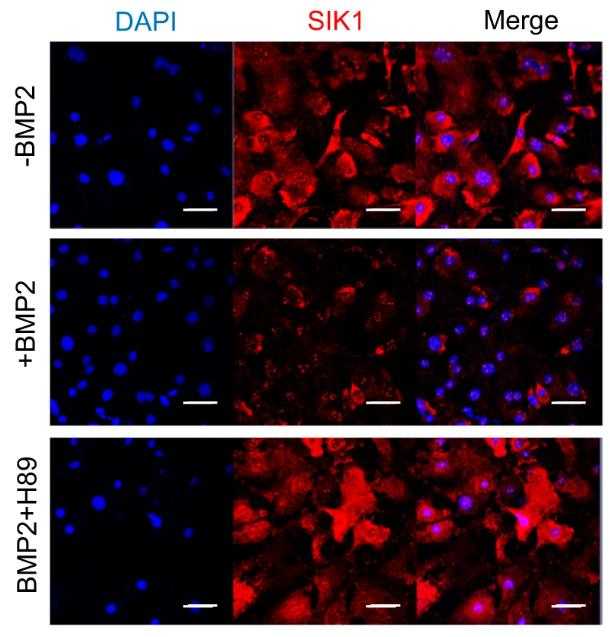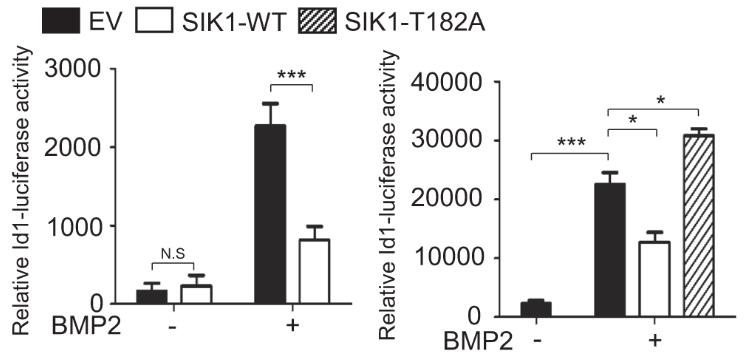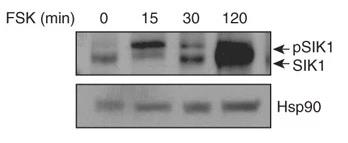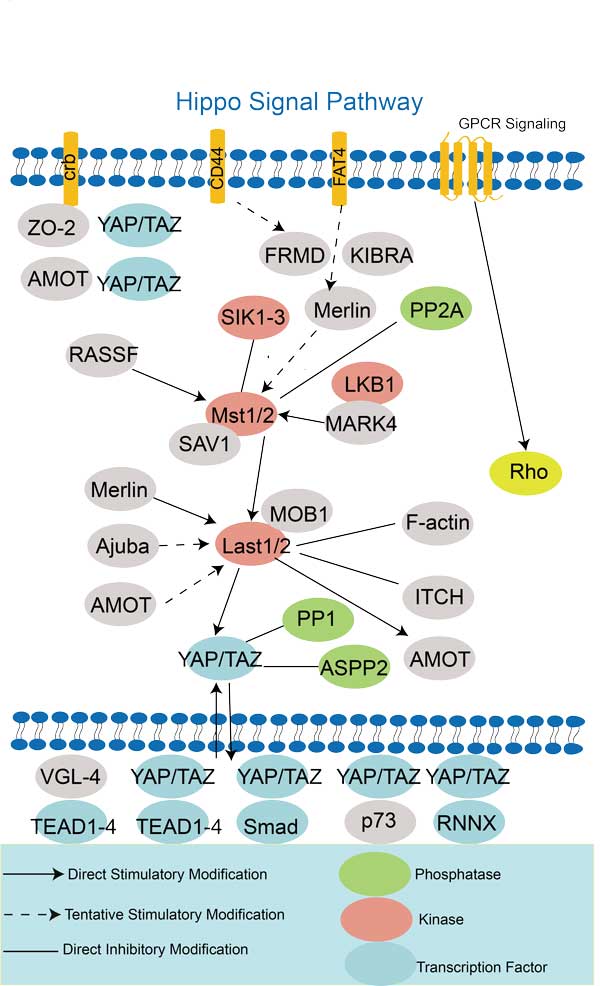SIK1
-
Official Full Name
salt-inducible kinase 1 -
Overview
Serine/threonine-protein kinase SIK1 is an enzyme that in humans is encoded by the SIK1 gene. -
Synonyms
SIK1;salt-inducible kinase 1;SNF1 like kinase , SNF1LK;serine/threonine-protein kinase SIK1;msk;myocardial SNF1 like kinase;SIK-1;SNF1-like kinase;myocardial SNF1-like kinase;salt-inducible protein kinase 1;serine/threonine protein kinase;serin
Recombinant Proteins
- Human
- Mouse
- Rat
- Chicken
- E.coli
- Insect Cell
- Mammalian Cell
- Sf9 Insect Cell
- HEK293
- His
- HIS
- GST
- Non
- His&Fc&Avi
| Cat.# | Product name | Source (Host) | Species | Tag | Protein Length | Price |
|---|---|---|---|---|---|---|
| SIK1-432H | Recombinant Human SIK1 protein, His-tagged | E.coli | Human | His | 1-350 a.a. | |
| SIK1-431H |
Active Recombinant Human SIK1 Protein, His-tagged
|
Insect Cell | Human | HIS | 1-303 a.a. |
|
| SIK1-15134M | Recombinant Mouse SIK1 Protein | Mammalian Cell | Mouse | His |
|
|
| SIK1-48H | Recombinant Human SIK, GST-tagged | Sf9 Insect Cell | Human | GST | 1-303 a.a. |
|
| SIK1-5402R | Recombinant Rat SIK1 Protein | Mammalian Cell | Rat | His |
|
|
| SIK1-6248C | Recombinant Chicken SIK1 | Mammalian Cell | Chicken | His |
|
|
| SIK1-1842HCL | Recombinant Human SIK1 293 Cell Lysate | HEK293 | Human | Non |
|
|
| SIK1-433H | Recombinant Human SIK1 protein, His-tagged | E.coli | Human | His | 337-564 aa |
|
| SIK1-5061R | Recombinant Rat SIK1 Protein, His (Fc)-Avi-tagged | HEK293 | Rat | His&Fc&Avi |
|
|
| SIK1-5061R-B | Recombinant Rat SIK1 Protein Pre-coupled Magnetic Beads | HEK293 | Rat |
|
||
| SIK1-8172M | Recombinant Mouse SIK1 Protein, His (Fc)-Avi-tagged | HEK293 | Mouse | His&Fc&Avi |
|
|
| SIK1-8172M-B | Recombinant Mouse SIK1 Protein Pre-coupled Magnetic Beads | HEK293 | Mouse |
|
Background
What is SIK1 Protein?
SIK1, also known as Salt-Inducible Kinase 1, is turning heads among scientists for its role as a sort of cellular "switch." This protein is part of a larger group of kinases that kick into action in response to stress signals like salt levels, which is where it gets its name. SIK1 is involved in multiple cellular activities, managing things like metabolism, how cells deal with stress, and potentially influencing cell growth and development. While researchers are still piecing together the full picture, getting to know SIK1 better could pave the way for new treatments for diseases tied to cellular stress and metabolic issues.
What is the Function of SIK1 Protein?
Salt-Inducible Kinase 1, or SIK1 for short, acts a bit like a cellular jack-of-all-trades inside our bodies. It's super involved in a variety of cell activities, including tweaking metabolism, managing stress reactions, and regulating gene expression. It even has a hand in how our immune system operates. Picture it as a flexible team player, making sure that all cellular operations remain steady while also adjusting to any new challenges or needs that arise. Understanding how SIK1 works may unveil new avenues for addressing issues related to cellular stress and metabolic disorders.
SIK1 Related Signaling Pathway
Imagine Salt-Inducible Kinase 1, or SIK1, as a key moderator in the cell's bustling information highway. As a member of the AMP-activated protein kinase (AMPK) family, this kinase is engaged in several essential roles. It acts as an energy manager by regulating glucose metabolism and also supports the body's circadian rhythm, keeping our internal clock aligned. Additionally, SIK1 jumps into action during stressful situations to keep the cellular environment stable. So, it's not just sitting idle; SIK1 is lively, ensuring that amidst all the cellular chaos, everything operates smoothly and efficiently.
SIK1 Related Diseases
SIK1 (Salt-Inducible Kinase 1) is believed to play a role in multiple diseases due to its involvement in crucial cell signaling pathways that affect cellular functions like metabolism and stress responses. Alterations or dysfunction in these pathways might contribute to various conditions. For example, disturbances in SIK1-related pathways could potentially be linked to metabolic disorders, as SIK1 influences glucose metabolism. Additionally, its role in cellular stress responses might make it relevant in conditions where stress plays a key component. Though research is ongoing, understanding SIK1's exact impact on specific diseases could lead to targeted therapeutic strategies in the future.

Fig1. The function of SIK1 in tumorigenesis. (Zicheng Sun, 2020)
Bioapplications of SIK1
Recombinant SIK1 proteins have caught the interest of both researchers and industry professionals due to their versatile applications. In scientific research, they're often employed as a tool to unravel cellular processes, helping scientists understand more about cell signaling and metabolism. On the industrial side, these proteins might play a part in developing new therapies or enhancing biotechnological processes. The possibilities span a wide range, although practical real-world implementations are still emerging.
Case Study
Case Study 1: Min Kyung Kim, 2019
There's a big need for new treatments to help with bone problems like osteoporosis, and here's where SIK1 (that's salt-inducible kinase 1) comes into play. In our study, we dug into how SIK1 affects bone-making cells, or osteoblasts. Turns out, knocking down SIK1 ramps up osteoblast activity and helps bones get stronger by aiding in matrix mineralization. SIK1 seems to have this bossy role, needing its own activity to keep osteoblasts in check. It gets all technical with CRTC1, stopping it from pushing genes that make bones grow like Id1. We even saw mice without SIK1 had more bone mass compared to regular mice. When it comes to bone growth signals like BMP2, they actually tone down SIK1's expression and activity via PKA pathways, boosting bone formation. So, the takeaway? SIK1 kind of acts like a brake on bone growth, and knowing how to release that brake could be key for new bone-building treatments.

Fig1. Primary preosteoblasts were treated with BMP2 for two days in the absence or presence of H89.

Fig2. Cell lysates were subjected to luciferase assay.
Case Study 2: Rebecca Berdeaux, 2007
When you hit the gym or start exercising, your motor neurons kick into gear and ramp up the activity of muscle-specific genes, thanks to something called the myocyte enhancer factor 2 (MEF2) family, which are transcription factors. These guys get a boost from the increase in intracellular calcium, which dials up their activity by shutting down class II histone deacetylases (HDACs) through a process called phosphorylation. In an experiment with mice, researchers looked into how a protein named cAMP responsive element binding protein (CREB) affects muscles. Turns out, mice with a messed-up version of CREB showed muscle issues and lowered MEF2 activity because their class II HDAC didn't get phosphorylated enough. Why? There was less Snf1lk, a gene that CREB usually triggers to help out with HDAC. But when scientists blocked HDAC activity with either a virus carrying Snf1lk or a special drug, the mice's muscles got better. So, it seems the SIK1-HDAC pathway is pretty key in keeping muscles working properly.

Fig3. Western blot showing amounts of SIK1 protein and Hsp90 control in primary cultures of NSM.

Fig4. Western blot assay showing the effect of RNAi-mediated knockdown of SIK1 on amounts of total and pHDAC5 protein.
Quality Guarantee
High Purity
.jpg)
Fig1. SDS-PAGE (SIK1-227H)
Involved Pathway
SIK1 involved in several pathways and played different roles in them. We selected most pathways SIK1 participated on our site, such as , which may be useful for your reference. Also, other proteins which involved in the same pathway with SIK1 were listed below. Creative BioMart supplied nearly all the proteins listed, you can search them on our site.
| Pathway Name | Pathway Related Protein |
|---|
Protein Function
SIK1 has several biochemical functions, for example, . Some of the functions are cooperated with other proteins, some of the functions could acted by SIK1 itself. We selected most functions SIK1 had, and list some proteins which have the same functions with SIK1. You can find most of the proteins on our site.
| Function | Related Protein |
|---|
Interacting Protein
SIK1 has direct interactions with proteins and molecules. Those interactions were detected by several methods such as yeast two hybrid, co-IP, pull-down and so on. We selected proteins and molecules interacted with SIK1 here. Most of them are supplied by our site. Hope this information will be useful for your research of SIK1.
YWHAZ;CRTC2;SUPT5H;RPL3;NMNAT1;CD247;YWHAE
SIK1 Related Signal Pathway
Resources
Related Services
Related Products
References



